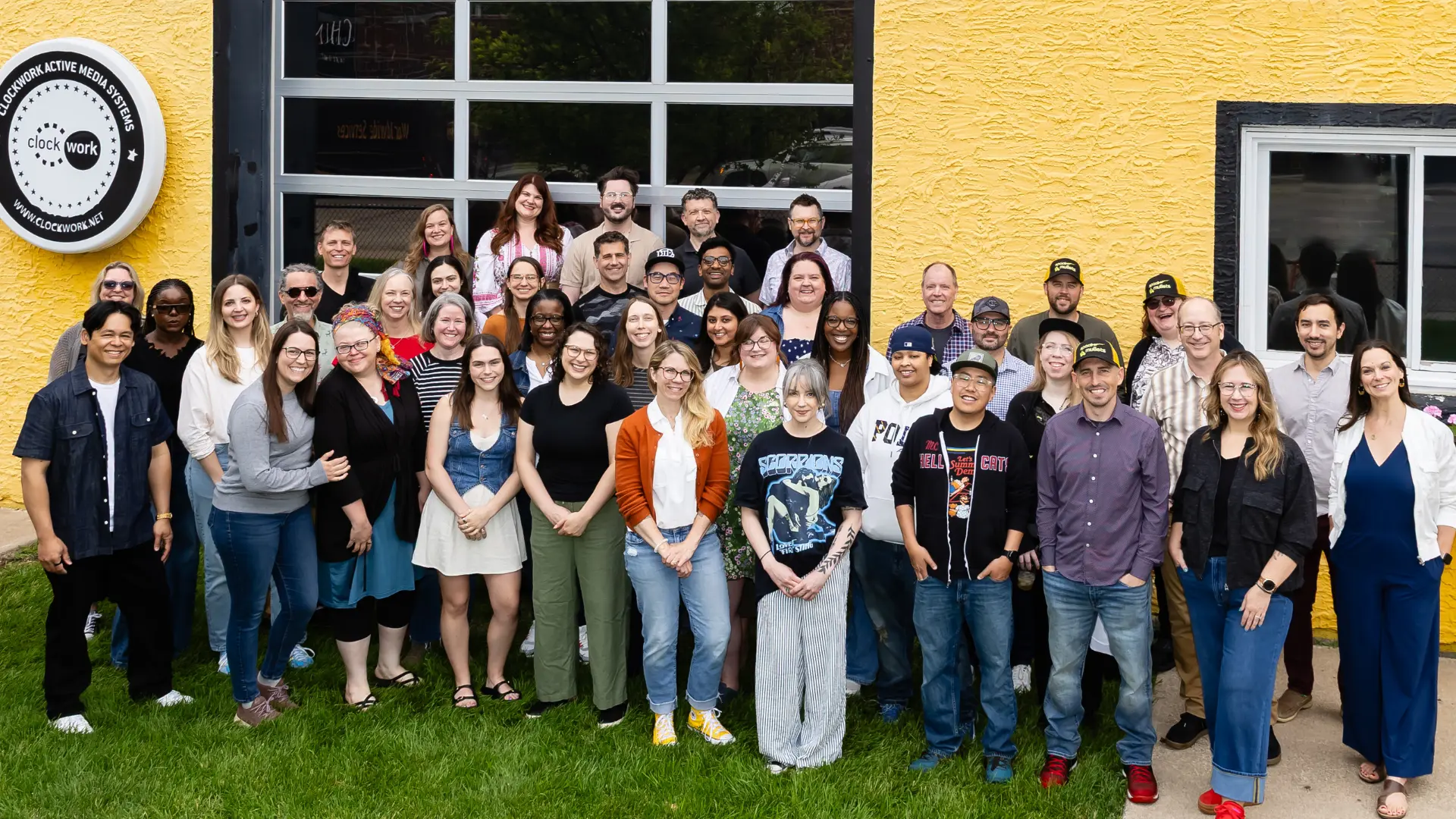It has been a whirlwind month since Clockworkers began working remotely. It’s hard to describe how much the world has changed in recent weeks. All of our patterns of behavior and expectations of “normal” have had to make innumerable shifts to keep up with the latest news, reality, and recommendations from government and health officials.
Even for companies like Clockwork, who are well-versed in working remotely, this period of time is unprecedented. Each of us has been doing our best to keep up with the waves of information, behavioral changes, and emotions that accompany so much instability. Our CEO, Nancy Lyons, said it best when she posted in our all-staff slack channel at the outset: “Go easy on yourselves and each other. We’ve never done this before.”
This is great advice for any leader and their team. In the last month, as we have worked to do this, we’ve also learned a lot of lessons and watched new themes emerge. We’re sharing the top five with you — and how we’ve worked to address them — in the hopes that they can help you and your teams navigate this change more effectively.
#1: This is not working from home as we have known it — this is something new
The first and biggest mistake leaders can make is to treat their current circumstance and employees as though this is a simple work-from-home arrangement. Last week, someone tweeted: “You are not working from home; you are at your home during a crisis trying to work.” This is an apt description of the scenario we all find ourselves in.
This is not situation normal where we are having a regular day, working from home. This is a global pandemic. One in which we are attempting to process a daily barrage of often sensationalized news coverage of infections and deaths… while also trying to play the role of teacher as our children attempt distance-learning… while trying to negotiate physical space and mental and emotional attention with our families… while being responsible for providing meals and cooking more than we ever have before… while attempting to go shopping for groceries and provisions less than we ever have before… while also working.
Whew.
It’s no wonder that everything feels difficult and complicated and overwhelming. It’s because this moment is difficult and complicated and overwhelming.
How can you address this?
By having patience and offering grace — to ourselves and to one another — and by acknowledging that the workday now looks very different. Build frameworks for teams to connect on a daily basis in order to identify priorities, but allow teams to accomplish these tasks in ways that acknowledge and accommodate the unprecedented circumstances we’re in. (For more on this, see our videos on setting teams up to succeed in remote environments)
#2: Be prepared for the dip in productivity
All change takes time and effort to absorb — especially change of the magnitude we’re now experiencing. Keep in mind that your employees are not only in the midst of a workplace change as a result of working remotely, they are also feeling similar change as it pertains to their personal lives and their freedom of movement through the world. It’s not a single aspect of life that is being disrupted, but every aspect of life. As a result of such upheaval, there are bound to be dips in productivity.
Dips, as in plural. With the introduction of change, there is often a corresponding dip in productivity. When dealing with multiple significant disruptions to our lives, it is only natural to expect multiple dips in productivity as we adopt a new normal.
How can you address this?
By acknowledging it and by planning for the productivity dips. It is important to allow teams the autonomy to set (and re-negotiate) deadlines based on their level of functioning on a day-to-day and week-to-week basis.
#3: Key elements of socializing have disappeared
A physical office environment — particularly a kitchen area, break room, or even a bathroom — creates opportunity to connect with co-workers; to form and build relationships separate from our work to-dos and outside of our immediate teams.
The kitchen table at Clockwork is exactly such a space. It’s where Clockworkers get to know one another and connect on shared interests outside of work. It’s a space where you can stop by for a few moments to grab a coffee and chat with folks you don’t directly work with.
As an article in Forbes recently pointed out, “Work is fundamentally social and even for those who are more introverted, human connection is an important part of the work experience.” While we may be on video or phone calls most of the workday, it is an entirely different type of connection to be collaborating on a work task, as opposed to talking reality TV while waiting for the coffee to finish brewing.
How can you address this?
By creating opportunities for socializing that are non-task-based. At Clockwork, we’ve set up a recurring meeting called “Coffee and Co-working” for an hour and a half each morning. You can also encourage team members to do things like call each other on walks or set up video lunch dates with co-workers not part of their day-to-day work.
#4 The peril of back-to-back meetings
While it’s true that meetings can add structure to your day and having some structure to the day is good, it’s also true that meetings can overtake and consume the entire day like an invasive species. In their article about why working from home is so exhausting, Forbes points out that “…one of the challenges of video conferencing in particular is its intensity. You’re looking at faces all day without being able to take visual breaks. Your eyes are focused on what is in close proximity, which is physically exhausting, but it can also be socially exhausting.”
Not only are you not able to take visual breaks when your day consists of back-to-back video calls, but you also are unable to take physical breaks. What looks ahead of time like a productive and effective use of your day can actually quickly deplete your employees to the point of burnout. It’s more important now than it’s ever been to make sure that any meeting that gets scheduled is truly needed and does not fall into the category of: this could have been handled via email.
How can you address this?
Encourage your teams to only schedule meetings when absolutely necessary. Encourage teams to build in 10-30 minutes between meetings to care for their bodies, their families, and any other needs. Encouraging your employees to consider phone meetings while they go for a walk outdoors is another way to ensure that productivity and health are both supported.
#5 Professional and personal are blurred in new ways
A team working remotely for a long time is in each other’s homes and lives in a way that is unprecedented and significant. Suddenly co-workers we may not have invited over are getting glimpses into our home offices. That is, if we’re lucky enough to have a dedicated space. More often, they’re seeing into our kitchens, living rooms, and sometimes even bedrooms. Our children, partners, and pets wander in and out of the background of our videos and sometimes exert themselves in the foreground if they have a question or need attention.
The professional and personal are suddenly mixed in a way most of us have never had to contend with and it can feel overwhelming and vulnerable. For employees who are used to using the privacy of their homes to recharge from the demands of work, it can feel as though there is no longer any space that remains sacred. They may struggle to recharge between the end of one workday and the start of the next. For those of us peering into the homes of our co-workers, feelings of jealousy or judgment can arise, as well. None of these things were factors in our previous work relationships and it can be hard to know how to process these new feelings.
How can you address this?
Promote empathy by modeling it yourself and by encouraging your employees to cultivate it for themselves and others. Encourage your employees to be aware of and own their emotions. It is important and healthy that they be able to communicate what they are feeling, but employees should never make their feelings the responsibility of others. Helping your staff learn the difference will be critical to navigating and succeeding in the new normal that is emerging as a result of our current circumstance.
If you need support in helping your team adapt and thrive in a remote work environment, contact us. We offer coaching, webinars, and more to support distributed teams in collaborating effectively and navigating change.




